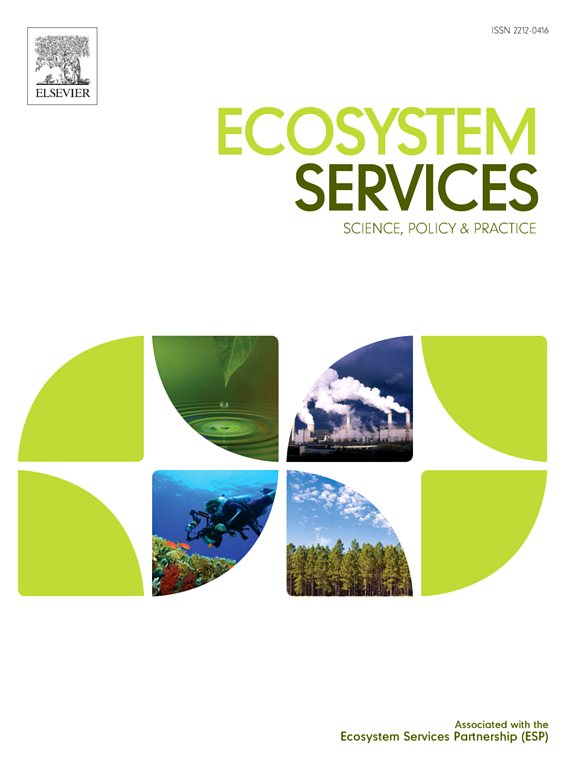利用扩展供应和使用表计算生态系统服务:以澳大利亚墨累-达令盆地为例
IF 6.6
2区 环境科学与生态学
Q1 ECOLOGY
引用次数: 0
摘要
我们使用环境经济核算系统-生态系统核算(SEEA EA)框架和澳大利亚墨累-达令盆地的案例研究来实施生态系统服务(ES)的自然资本核算。提出了扩展的ES供应使用表,允许同时报告多个中间和最终ES以及传统国民经济账户中已有的数据。我们涵盖了作物供应、放牧生物量供应、供水、土壤侵蚀控制、休闲钓鱼以及碳封存和储存的生态系统。这项研究表明,使用实物和货币措施的扩展ES供应-使用表可以在SEEA - EA和传统国民经济核算中记录的信息之间提供可行的联系,尽管不一定是完整的联系。它将中间环境效益、最终环境效益和生产的产品和服务集成在一个表中,并有助于区分效益与创造这些效益的投入。展望未来,需要更综合地记录经济和生态系统对福祉的贡献,以更好地理解自然带来的好处。本文章由计算机程序翻译,如有差异,请以英文原文为准。
Accounting for ecosystem services using extended supply and use tables: A case study of the Murray-Darling Basin, Australia
We implement natural capital accounts for ecosystem services (ES) using the System of Environmental-Economic Accounting – Ecosystem Accounting (SEEA EA) framework and a case study from the Murray-Darling Basin, Australia. Extended ES supply-use tables are presented that allow for the simultaneous reporting on multiple intermediate and final ES alongside data already available in traditional national economic accounts. We cover the ES of crop provisioning, grazed biomass provisioning, water supply, soil erosion control, recreational fishing, and carbon sequestration and storage. This study shows that extended ES supply-use tables using physical and monetary measures can provide feasible, although not necessarily complete, links between information recorded in the SEEA EA and traditional national economic accounts. It provides an integration of intermediate ES, final ES and produced goods and services in a single table and helps to distinguish benefits from the inputs that create these benefits. Going forward, more integrated recording of the economy and ecosystems’ contributions to wellbeing is needed to better understand the benefits derived from nature.
求助全文
通过发布文献求助,成功后即可免费获取论文全文。
去求助
来源期刊

Ecosystem Services
ECOLOGYENVIRONMENTAL SCIENCES&-ENVIRONMENTAL SCIENCES
CiteScore
14.90
自引率
7.90%
发文量
109
期刊介绍:
Ecosystem Services is an international, interdisciplinary journal that is associated with the Ecosystem Services Partnership (ESP). The journal is dedicated to exploring the science, policy, and practice related to ecosystem services, which are the various ways in which ecosystems contribute to human well-being, both directly and indirectly.
Ecosystem Services contributes to the broader goal of ensuring that the benefits of ecosystems are recognized, valued, and sustainably managed for the well-being of current and future generations. The journal serves as a platform for scholars, practitioners, policymakers, and other stakeholders to share their findings and insights, fostering collaboration and innovation in the field of ecosystem services.
 求助内容:
求助内容: 应助结果提醒方式:
应助结果提醒方式:


